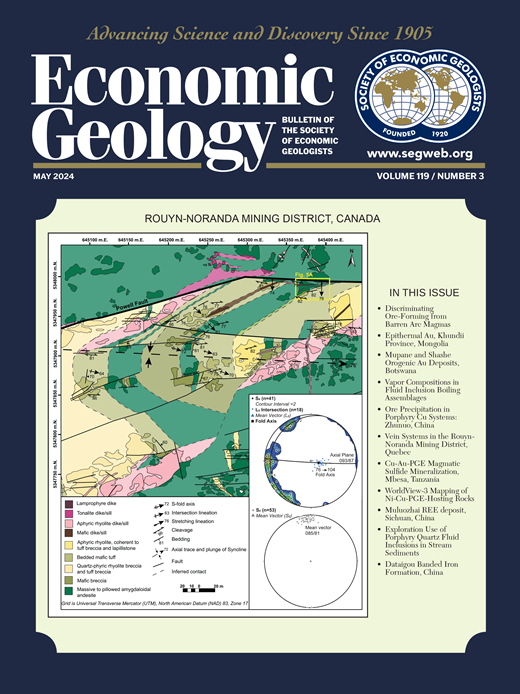Fluid Flow, Alteration, and Timing of Cu-Ag Mineralization at the White Pine Sediment-Hosted Copper Deposit, Michigan, USA
IF 4.9
1区 地球科学
Q1 GEOCHEMISTRY & GEOPHYSICS
引用次数: 0
Abstract
White Pine, located in Michigan’s Upper Peninsula, is an archetypal sediment-hosted stratiform copper deposit. The Midcontinent rift system is one of only seven basins globally that host a giant sediment-hosted stratiform copper deposit. Despite many similarities with other deposits of this type, White Pine displays some important differences, including the late Mesoproterozoic age, a thick basalt sequence, an apparent lack of evaporites, and a lacustrine depositional setting. This study analyzes paleofluid flow related to the formation of White Pine and places a particular emphasis on structural and diagenetic fluid pathways. Most of the ore is located in a 30-m-wide zone spanning the Copper Harbor Formation red beds and the overlying Nonesuch Formation shales. Sedimentation of these units was accompanied by subtle synsedimentary faulting. Premineralization phases include calcite concretions and nodules, illite and hematite grain coatings, isopachous chlorite rims, emplacement of liquid petroleum (now pyrobitumen), and bleaching. Mineralization introduced native copper into the footwall sandstones and a zoned suite of native copper and sulfur-poor copper sulfide minerals across a migrating redox front in the overlying shales where copper minerals nucleated on authigenic and detrital chlorite grains. Postmineralization phases include quartz cement, calcite cement, and calcite veins that partially overlapped inversion of synsedimentary faults. Contrary to previous studies, we identified evidence for only one phase of mineralization. An Re-Os chalcocite age of 1067 ± 11 Ma places mineralization 11 to 17 m.y. after host-rock deposition. Sulfide δ34S values of –14.0 to 29.9‰ suggest an important contribution from sour gas and thermochemical sulfate reduction of seawater. Carbon (δ13C) and oxygen (δ18O) isotope compositions of five calcite generations range from –15.1 to –1.3‰ and 10.4 to 41.3‰, respectively, and record early meteoric pore water displaced by later seawater. White Pine is both a sediment-hosted stratiform copper deposit and a paleo-oil field. Synsedimentary faults controlled the sedimentological character of the upper Copper Harbor Formation, and together these imparted a strong control on fluid flow and later diagenetic processes. Early oxidized meteoric fluids were displaced by liquid petroleum and sour gas, which were in turn succeeded by metal-rich but sulfate-poor oxidized seawater. Burial compaction during deposition of the overlying Freda Formation drove fluids through White Pine due to its situation on a paleotopographic high near the basin margin. Mineralization occurred at ~125°C at depths of ~2.0 km and spanned incipient basin inversion related to the distal effects of Grenvillian orogenesis. The hightenor copper mineral assemblage is the product of an abundant supply of metal from basaltic volcanic detritus in the Copper Harbor Formation and low seawater sulfate concentrations in late Mesoproterozoic oceans. This demonstrates that viable sediment-hosted stratiform copper systems can form when a readily leachable metal source rock is present, even if hypersaline and sulfate-rich brines are not.美国密歇根州白松沉积铜矿床的流体流动、蚀变及铜银成矿时间
白松铜矿位于密歇根州上半岛,是一个典型的沉积层状铜矿床。中大陆裂谷系是全球仅有的七个拥有大型沉积岩层状铜矿床的盆地之一。尽管与该类型的其他矿床有许多相似之处,但白松显示出一些重要的差异,包括中元古代晚期,厚玄武岩层序,明显缺乏蒸发岩和湖泊沉积环境。本研究分析了与白松形成有关的古流体流动,特别强调了构造和成岩流体通道。大部分矿石位于一个30米宽的区域,横跨Copper Harbor组红色层和上覆的nonessuch组页岩。这些单元的沉积伴随着微妙的同沉积断裂作用。预矿化阶段包括方解石结核和结核、伊利石和赤铁矿颗粒涂层、等渗绿泥石边缘、液态石油(现在是焦沥青)的侵位和漂白。矿化作用将天然铜引入下盘砂岩,并将一套分带的天然铜和贫硫铜硫化物矿物穿过上覆页岩的迁移氧化还原锋,其中铜矿物在自生和碎屑绿泥石颗粒上成核。成矿后相包括石英胶结、方解石胶结和方解石脉,它们部分重叠于同沉积断层反转。与以前的研究相反,我们只发现了一个矿化阶段的证据。Re-Os辉铜矿年龄为1067±11 Ma,成矿时间为寄主岩沉积后11 ~ 17 Ma。硫化物δ34S值为-14.0 ~ 29.9‰,表明酸性气体和海水热化学硫酸盐还原作用是重要贡献。5代方解石的碳(δ13C)和氧(δ18O)同位素组成范围分别为-15.1 ~ -1.3‰和10.4 ~ 41.3‰,记录了早期大气孔隙水被后期海水置换。白松既是沉积型层状铜矿床,又是古油田。同沉积断裂控制了上铜港组的沉积学特征,并对流体流动和后期成岩作用起着重要的控制作用。早期氧化的大气流体被液态石油和酸性气体取代,继而被富金属但缺乏硫酸盐的氧化海水取代。上覆的Freda组沉积时的埋藏压实作用,使得白松组位于盆地边缘附近的古地形高点,促使流体通过。成矿发生在~125°C,深度~2.0 km,跨越了与格伦维里安造山远端作用有关的早期盆地反转。铜港组玄武岩火山碎屑中大量的金属供应和中元古代晚期海洋中较低的海水硫酸盐浓度是高含量铜矿物组合的产物。这表明,当存在易于浸出的金属源岩时,即使不存在高盐和富含硫酸盐的盐水,也可以形成可行的沉积物层状铜系统。
本文章由计算机程序翻译,如有差异,请以英文原文为准。
求助全文
约1分钟内获得全文
求助全文
来源期刊

Economic Geology
地学-地球化学与地球物理
CiteScore
10.00
自引率
6.90%
发文量
120
审稿时长
6 months
期刊介绍:
The journal, now published semi-quarterly, was first published in 1905 by the Economic Geology Publishing Company (PUBCO), a not-for-profit company established for the purpose of publishing a periodical devoted to economic geology. On the founding of SEG in 1920, a cooperative arrangement between PUBCO and SEG made the journal the official organ of the Society, and PUBCO agreed to carry the Society''s name on the front cover under the heading "Bulletin of the Society of Economic Geologists". PUBCO and SEG continued to operate as cooperating but separate entities until 2001, when the Board of Directors of PUBCO and the Council of SEG, by unanimous consent, approved a formal agreement of merger. The former activities of the PUBCO Board of Directors are now carried out by a Publications Board, a new self-governing unit within SEG.
 求助内容:
求助内容: 应助结果提醒方式:
应助结果提醒方式:


